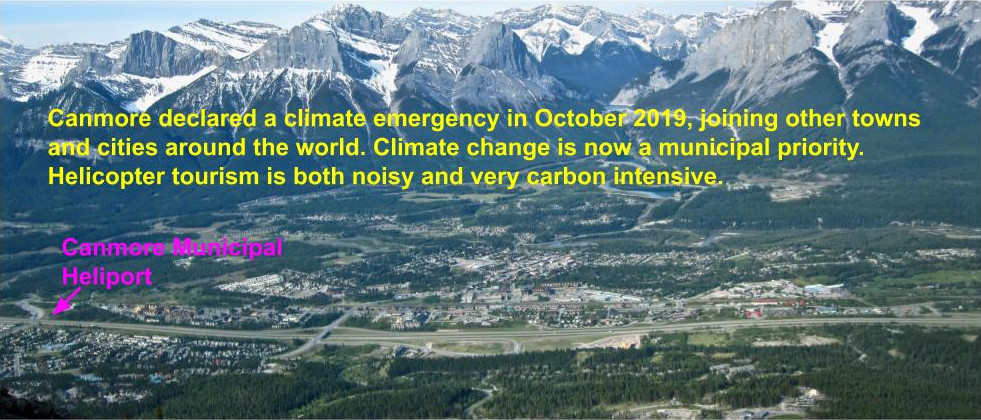The Bow Valley Helicopter Noise Alliance (BVHNA) is a Canmore-based volunteer group. BVHNA is not “anti-helicopter”. Our objective is to ensure that the Canmore Municipal Heliport is properly sized and located, and that helicopter tourism does not disturb people and wildlife.
As discussed above, the first problem is a poorly located Canmore Municipal Heliport with particularly loud 206L helicopters. The second problem is helicopter overflights---usually sightseeing tours--- in parks that disturb people and wildlife.
As shown on the map below, the Canmore area is adjacent to Banff National Park, a UNESCO World Heritage Site, and is surrounded by various provincial parks: Bow Valley, Spray, Lougheed, Assiniboine, etc.
In 2017, 4.18 million [+] people visited Banff National Park. The number for Kananaskis Country, the group of largely provincial parks adjacent to Banff, is approximately [+] 1.5 million. The combined total is over 5.5 million visitors annually.
How many visitors to the area choose helicopter flightseeing? According to information provided by the Town of Canmore, Alpine Helicopters flew 21,545 flightseeing guests in 2017, comprising 80% to 85% of Alpine’s total flights. That works out to 0.39% of total visitors, yet this small percentage has a very large disturbance footprint. Many people in parks (and neighborhoods) object to loud, disruptive disturbances, especially if such disturbances are non-emergency in nature, and caused by another type of recreational activity (ie., helicopter sightseeing). The analogy is a loud music in a library or church.
Regarding overflight altitudes for parks, Transport Canada states:
To preserve the natural environment of parks, reserves and refuges and to minimize the disturbance to the natural habitat, overflights should not be conducted below 2 000 feet AGL
(AGL - Altitude above ground level)
Within 2000ft (600m), the 206L helicopters used by Alpine would be 66.6 dBA or louder. This exceeds the common maximum for municipal noise bylaws for residential/commercial areas. More appropriate, would be the municipal “quiet zone” maximum of 55 dBA [+], which is generally defined as the area within the property lines of a residential lot. Using the 55 dBA maximum regarding a “quiet zone”, the 206L helicopters would need to fly at least 2 km away from people.
It is noteworthy that the 2 km buffer distance is applicable to both people and wildlife. Mountain goats are very sensitive to helicopter noise. An Alberta study of the effects of helicopters on mountain goats recommended that helicopters stay 2 km [+] away from areas with mountain goats.
Disturbance to both people and wildlife in parks puts the spotlight on helicopter sightseeing. Is it something that should occur in national and provincial parks? If so, how should it be managed? Unfortunately, some flightseeing pilots often disregard Transport Canada’s 2,000ft (≥600m) minimum rule while conducting flightseeing trips over parks, and pass over mountain tops and ridges at 100m or less. What can be done about this, and how?
Other locations take this issue very seriously. Grand Canyon National Park has over 20 documents pertaining to overflights and their impact on the Park’s soundscape [+].
To address impacts on parks visitors and resources, overflights below 14,500ft. (4.42 kms) are generally not allowed, or restricted to specific areas.

Helicopter sightseeing is an extremely carbon-intensive type of recreation. Should that aspect be considered given one of Canmore’s key guiding principle is to “Support programs and initiatives that minimize our contribution to or mitigate the impacts of climate change”? [+] The Town has authority over the commercial use of its municipal heliport, and decides the types and numbers of flights allowed.

Transport Canada ≥600m/2000ft rule


This FAA report outlines the noise reduction benefits associated with higher altitude flight.
A 5 dBA decrease is roughly equivalent to a 50% reduction in the noise level you hear.